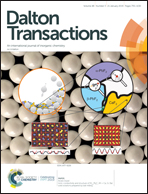Fabrication of core–shell α-MnO2@polydopamine nanocomposites for the efficient and ultra-fast removal of U(vi) from aqueous solution†
Abstract
The development of functional nanoparticles with ultra-fast and high adsorption capacities is an important strategy for wastewater treatment. Here, α-MnO2@polydopamine nanocomposites (α-MnO2@PDAs) were synthesized by coating α-MnO2 nanowires with polydopamine and were used to remove U(VI) from solutions. The α-MnO2@PDAs possessed a large surface area (22.8 m2 g−1), excellent dispersibility, and abundant surface functional groups. The adsorption of U(VI) was clearly influenced by pH rather than ionic strength, which suggested inner-sphere surface complexation. The adsorption could reach equilibrium within 5 min, and the kinetics was well fitted by the pseudo-second-order model. The maximum adsorption capacity determined from the Langmuir model at 298 K and different pH values was in the order of pH 5.0 (383.14 mg g−1) > 8.0 (213.22 mg g−1) > 3.0 (158.73 mg g−1), which indicated that the α-MnO2@PDAs could still remove U(VI) efficiently at a pH of 8, which is close to the pH of natural water. Spectroscopic analyses suggested that favourable adsorption occurred on active binding sites, e.g., phenolic O–H and amide functional groups. The higher removal efficiency of the α-MnO2@PDAs for U(VI) was due to electrostatic attraction and surface complexation. Moreover, the practical applicability of the α-MnO2@PDAs in the treatment of real wastewater was confirmed by their high adsorption capacity for U(VI) from natural or synthetic water.



 Please wait while we load your content...
Please wait while we load your content...